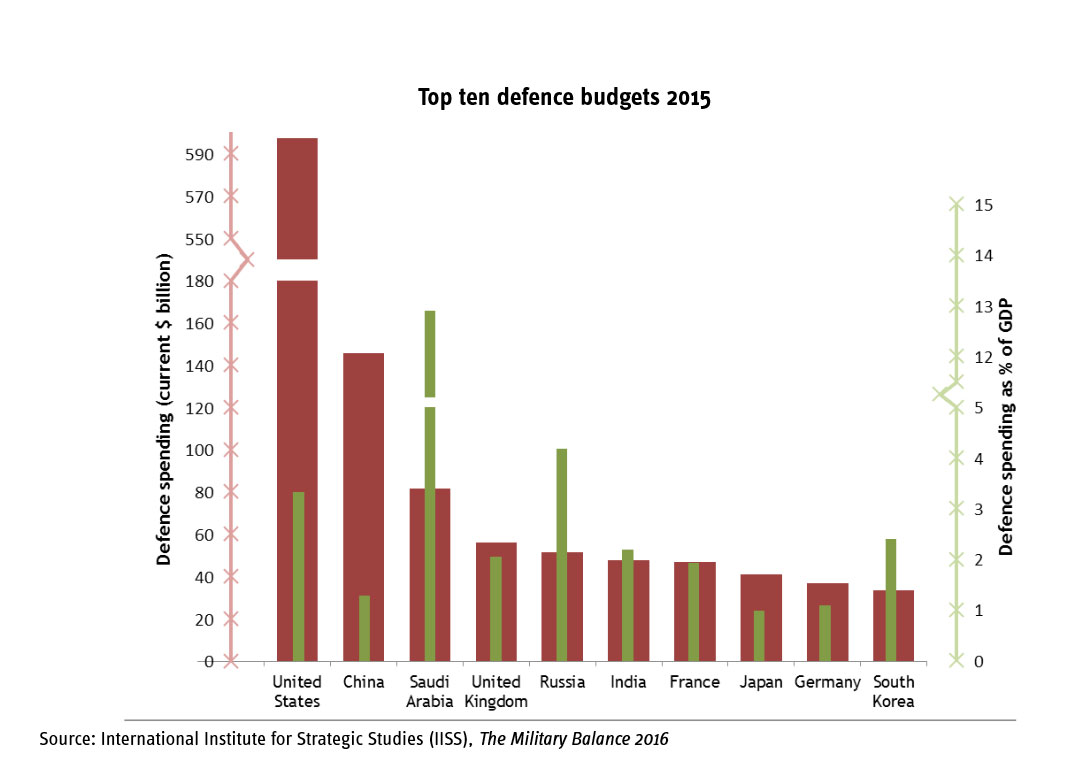Global Defence Spending 2015: The Big Picture
10 Mar 2016
By Katharina Wolf for European Union Institute for Security Studies (EUISS)
This article was external pageoriginally publishedcall_made by the external pageEuropean Union Institute for Security Studies (EUISS)call_made in February 2016.
According to the Military Balance 2016, recently published by the International Institute for Strategic Studies (IISS), global defence spending in 2015 amounted to $1.563 trillion – with the US, China, Saudi Arabia and Russia accounting for more than half of total expenditure. For its part, ‘EUrope’ has largely reversed its trend of cutting budgets and accounts for roughly 14.5% of the world’s spending. While the US has long stood out as the world’s pre-eminent power, the rapid expansion of budgets by regional powers has multiplied tensions in Asia, the Middle East and North Africa (MENA), and Russia and the post-Soviet space. Yet, rises in defence spending did not always result in the outbreak of conflicts. Overt military aggression predominantly occurred where states proved willing to spend excessively on defence and have little concern for the consequences military action would have on the external security environment and their own internal stability.
Between Moscow and Riyadh
The decision to intervene militarily in support of the Syrian regime in September 2015 signalled that Moscow is determined to assert itself even if it punishes Russian society domestically. In spite of worsening economic prospects due to plummeting oil prices, the Kremlin’s own mismanagement, and the bite of Western sanctions, Russia increased defence spending by roughly 19% between 2013 and 2015. This amounts to some $51.6 billion worth of investments in the defence sector in 2015 and accounts for 4.2% of GDP (compared to 3.2% in 2013).
Saudi Arabia’s 2015 military activities have shown a similar tendency towards escalation – be it in Yemen, Syria or elsewhere in the region. With a total amount of $81.9 million of military investments made, Saudi Arabia had the world’s third-highest defence outlays in 2015. Gloomy economic prospects due to tumbling oil prices have done little to change the kingdom’s bold posture in foreign affairs. Despite GDP shrinking, Riyadh boosted defence spending by 17% in real terms over the last two years, and in 2015, the defence sector accounted for 13% of the country’s GDP. The simultaneous launch of Northern Thunder, the largest military exercise in the history of the MENA with 20 participating countries as part of the new Saudi-led Islamic anti-terrorist coalition, is another sign that Riyadh is prepared to maintain its tough stance towards the region’s challenges.
Asian concerns
In Asia, China’s continued enhancement of its military capabilities reinforced concerns about Beijing’s intentions, especially in light of its provocative actions in the South China Sea. Beijing not only has the world’s second highest defence expenditure after the US ($145.8 billion in 2015), but it has also shown determination to boost spending massively with an average annual rate of roughly 9% for the last two years.
Concerns over China’s intentions – in addition to North Korea’s aggressive nuclear policy – have driven India, South Korea and Japan to bolster their defences, too. Yet, in contrast to Saudi and Russian military spikes, Asia has not witnessed overt military confrontation. The stakes are somewhat higher in the region: it features four of the world’s ten largest defence spending countries, two of which possess nuclear weapons. What is more, the US has interests – and allies – in the region and is unlikely to tolerate any threat to the freedom of navigation.
How China’s military activities are perceived by its neighbours matters. Until now, China’s growing military power has been tied to the country’s powerful economic growth. And in 2015, a (financially) modest 1.3% of GDP was devoted to the defence sector. Asian states will thus keep an eye on Beijing’s dedication to continue to spend on defence and related military activities as its economic growth slows.
European constraints
European defence spending patterns reveal how seriously economic constraints can weigh on defence budget decisions and, more indirectly, on overall military preparedness. For many years, European defence spending was in a downward spiral, with the austerity measures imposed on budgets following the financial crisis playing a big role. With its immediate environment to the south and east in turmoil, it seems Europe is now starting to take defence more seriously. Not only are defence budgets in large parts of Europe rising again – France, Germany and the UK will all increase spending in 2016 – but the willingness to spend more has also been accompanied by a fresh emphasis on the security of the European ‘homeland’.
How much states spend on defence – in actual but also in relative terms – can explain a great deal about their foreign policy behaviour. Not only does it indicate the importance of the military as a foreign policy instrument, but it can also show the burdens which states are prepared to place on their societies and the willingness of domestic populations to shoulder them. Despite slowing economic growth, Russia, Saudi Arabia and China seem determined to keep investing in the modernisation of their military capabilities. Even if economic stagnation will make it increasingly difficult to allocate larger shares of governmental spending to their defence sectors in the long run, excessive spending seems likely to continue in the near future. In contrast, military spending in Europe is much more constrained by wider considerations of socio-economic stability and development.
Ultimately, however, defence spending patterns say little about how future investments are made and in which military capabilities. Given tomorrow’s uncertainties, a stronger financial commitment to defence is only one component to keep Europe safe; investments into the assessment of future threats to European security and the development of cutting-edge defence capabilities to counter them are equally essential.


